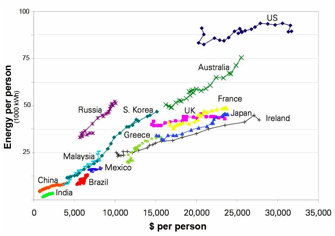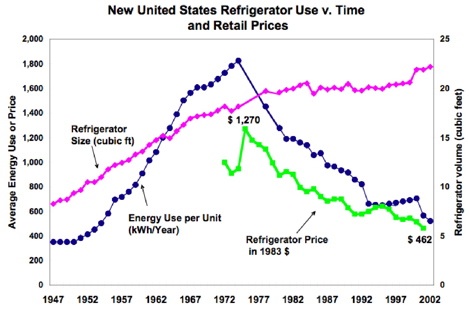 I recently posted about a talk I saw about meeting our global energy needs in the future. To me, one of the frustrating things about the whole conversation is that there aren’t hard numbers comparing one scenario to another. For example, I’ve heard that if we cover all of New Mexico in solar cells, we could meet the energy demands of the entire nation. However, I’ve not heard how much that would cost and how that compares to say building new nuclear power plants.
I recently posted about a talk I saw about meeting our global energy needs in the future. To me, one of the frustrating things about the whole conversation is that there aren’t hard numbers comparing one scenario to another. For example, I’ve heard that if we cover all of New Mexico in solar cells, we could meet the energy demands of the entire nation. However, I’ve not heard how much that would cost and how that compares to say building new nuclear power plants.
Clearly, I’m not the only one with this frustration. And someone has done something about it. David J.C. MacKay, Professor of Natural Philosophy in the Department of Physics at University of Cambridge, is working on a book to answer precisely these questions. As he says, we need “numbers, not adjectives” in trying to decide how to both meet our energy needs and to reduce our green house emissions. On his website, Without the Hot Air, he presents a draft of a book in which he compares the possible energy sources available to Great Britain with the energy consumption they are currently using. I’ll admit I haven’t read his book, yet, but I went through some of his slides and his executive summary, also available on his website. The upshot: Britain cannot generate the power it currently uses from renewable sources available only within Britain. And that is if, for example, all land in GB was used for power generation of one sort or another, which, as he points out in his slides, would make a lot of people unhappy (he shows protests against off-shore wind farms, where the protestors bemoan the destruction of scenary).
And, as opposed to a lot of people who bemoan our current situation (i.e. Al Gore), Dr. MacKay gives concrete plans that embody different policies (such as a Green plan which uses no coal or nuclear to an Economic plan that relies heavily on nuclear) to solve Britain’s energy problem. These rely upon two things: increasing energy production, which in the case of Britain seems to involve getting power from other countries that can produce more renewable energy, and decreasing energy consumption. Both are key to a solution to the problem.
One interesting side tidbit I saw in his slides: I guess one reason people don’t like windmills is that they kill birds. He compares the number of birds killed in Denmark, which has a much higher number of windmills than GB, by windmills and cars and the number killed in GB by cats. The number killed by cars dwarfs those killed by windmills, and the numbers killed by cats are many orders of magnitude greater than either. Just an interesting tidbit.
Anyways, without hard analysis like Dr. MacKay’s and the corresponding realistic look at possible solutions, we will never solve the energy problem. A prime example is biofuels. Biofuels are touted as a great advance in addressing the problem. However, everything I’ve read suggests biofuels are, at best, a distraction and will not help in any significant way. That they are so highly touted by politicians and the like just distracts us from real solutions.
Some other links I found on Dr. MacKay’s site: his blog, where he discusses energy claims in the media and other aspects of energy consumption and Sandy Polak’s site, which discusses ways to reduce your carbon footprint that are realistic.
(The figure is from Dr. MacKay’s website.)
Like this:
Like Loading...
 Yesterday, while riding to work, I heard the NPR story on the testing of the Large Hadron Collider. The purpose of this massive machine (though still about 3 times smaller than the Superconducting Super Collider would have been…) is to probe the basic building blocks of the universe. The subatomic world made up of bosons, quarks, and so on. The particles that carry mass, for instance, that give the bigger particles (protons, electrons, neutrons) their mass.
Yesterday, while riding to work, I heard the NPR story on the testing of the Large Hadron Collider. The purpose of this massive machine (though still about 3 times smaller than the Superconducting Super Collider would have been…) is to probe the basic building blocks of the universe. The subatomic world made up of bosons, quarks, and so on. The particles that carry mass, for instance, that give the bigger particles (protons, electrons, neutrons) their mass. I recently posted about a talk I saw about meeting our
I recently posted about a talk I saw about meeting our 
